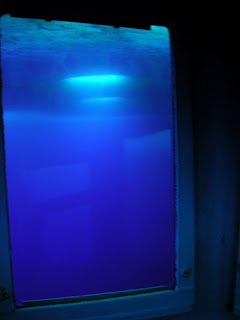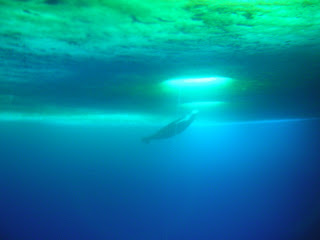One of the hard things about working here in Antarctica is that while I am in this incredible place of adventure I spend well over 90 percent of my time inside. The vast majority of this time is spent either sleeping or washing dishes. But occasionally we do get to leave the galley and to 'experience' a bit of Antarctica. On this particular day I got to join a guy and head out to the 'Penguin Ranch' in order to help begin to take it apart.
At the penguin ranch, what they do is they get a handful of penguins from the area, emperor penguins. Then they find a big patch of ice with no holes or cracks in it. Then they drill two holes through the ice down into the sea water. They then put up fences around the holes / a corral, and the penguins are now free to come and go out of the holes as they please, but due to the fact that there are no other holes within a reasonable distance, they thus return to the 'ranch.' There is a group of scientists who study the penguins here. They study all sorts of things from the length and depth of their dives, to their food consumption, to water temps, and so on. It is really pretty interesting.
However, once I got there the 'corral' had been taken down, and the penguins had hit the road to freedom. In the second picture you can see a big ol' Caterpillar. We rode out to the ranch in this tractor on the sea ice. Once there, Tom the driver, spent the day bulldozing snow away from the buildings getting them ready to be removed back to the station. I helped out by shoveling snow away from the buildings so that he could bulldoze. But I also got to just hang out.
In the first picture you may be able to see a small green tube sticking up out of the snow. This is the 'ob tube' (observation tube). There is a hole drilled down through the ice, and then the ob tube is lowered down this hole. One can then climb down this tube, and sit underneath the ice and watch the world below the ice, as there are windows at the bottom giving one a 360 degree view. It was pretty neat. It was hard to realize that I was actually under the sea ice in Antarctica and not at a zoo somewhere.
It was pretty slow paced down in the Ob Tube. As I said all the penguins were gone. But you can see the seal I got to see. When we first got there he was hauled out on the ice, and just hanging out, and then in the afternoon, he decided that it was time to get in and go for a swim. I thought of joining him, but figured I would postpone my swim. It was rather surreal watching this seal float/swim in this weightless environment, as on land they are just big slugs. Looking at the ice holes from below looked like one was looking up into 'portals' in the sky.


Sometimes they have to transport the penguins from far away, and when they have to do this they capture them, and put them in boxes like this one. The 'penguin packer.'


Looking down the Ob Tube.



